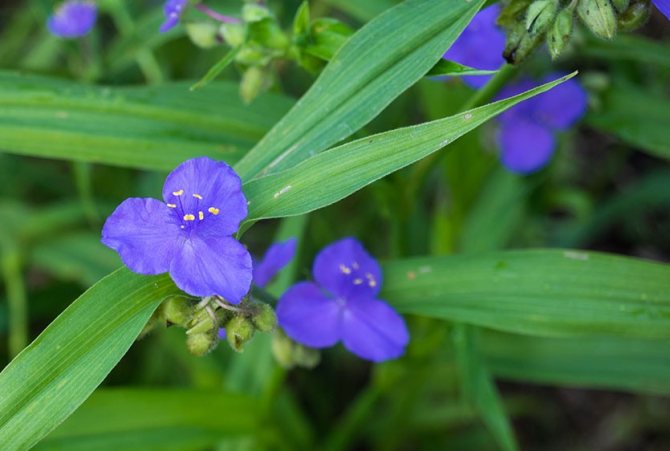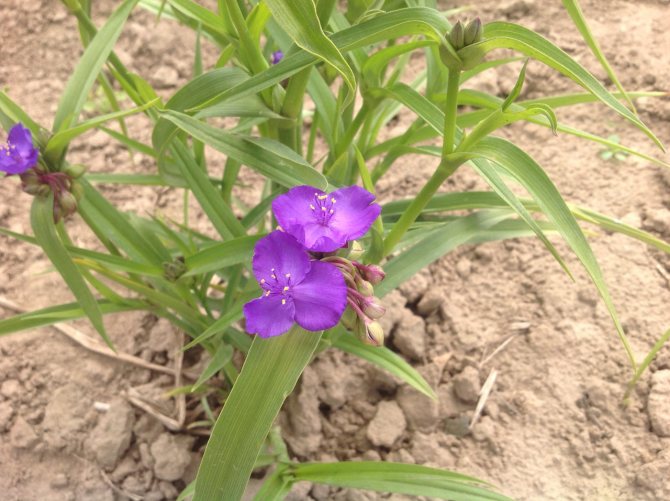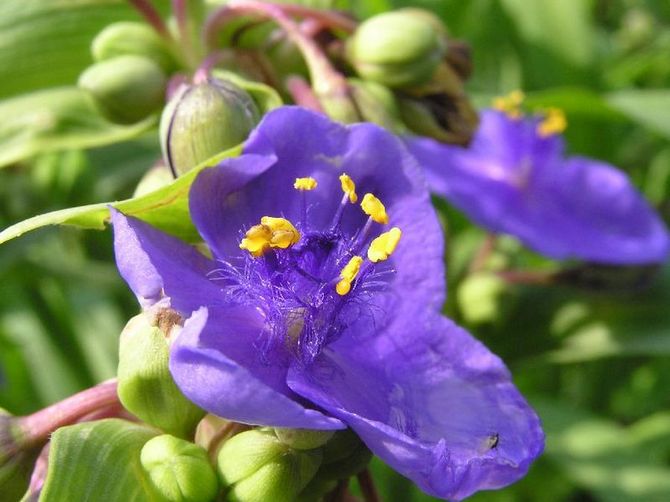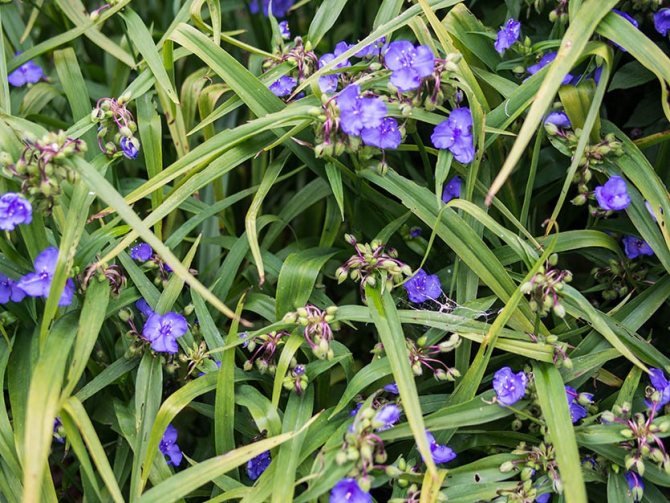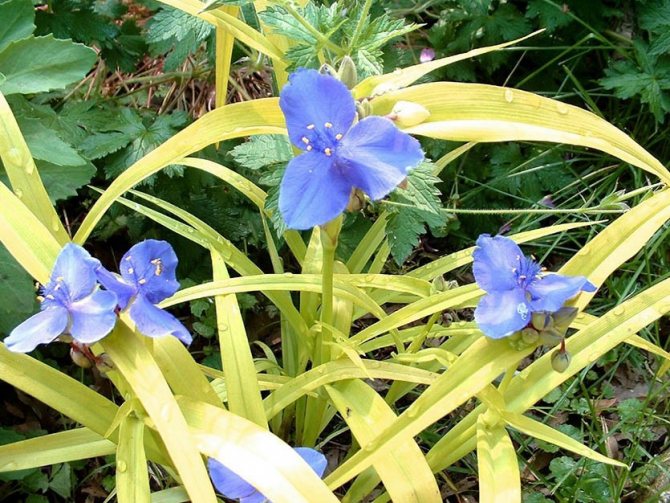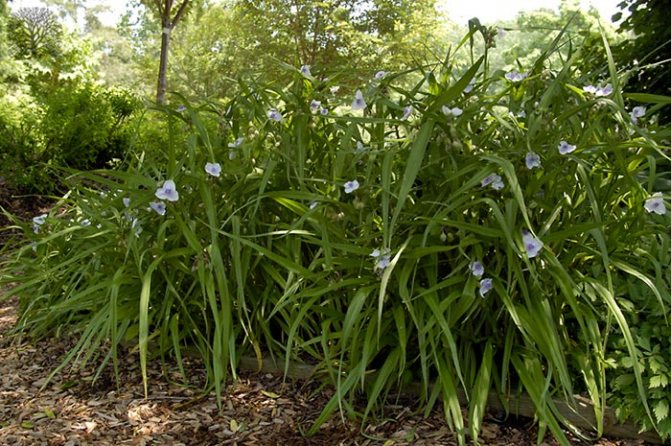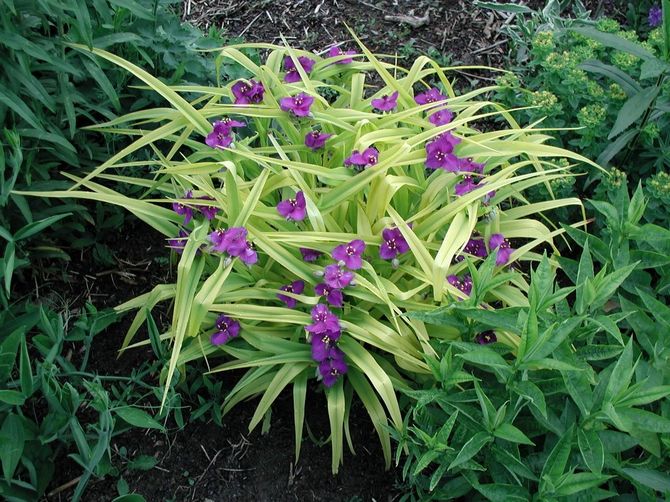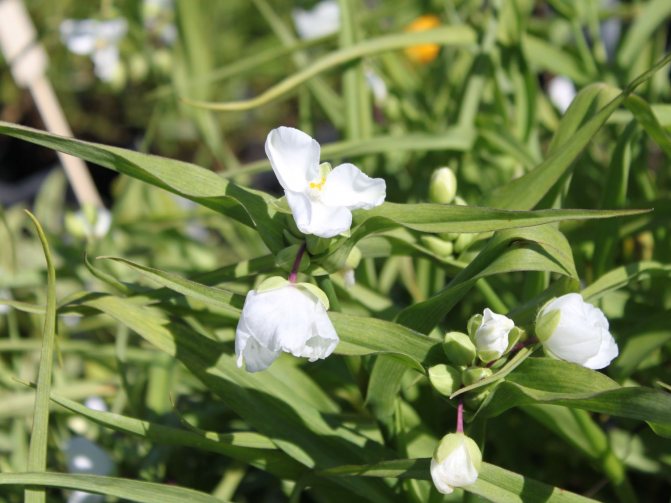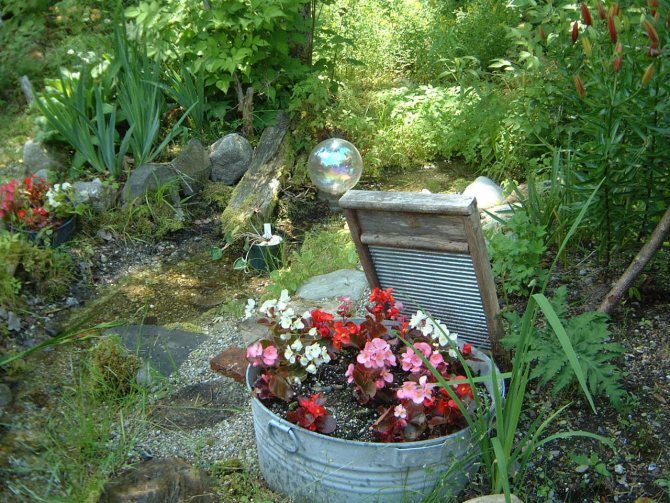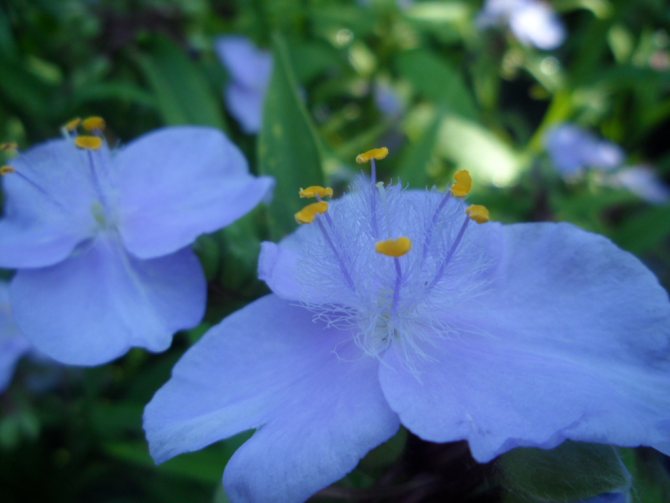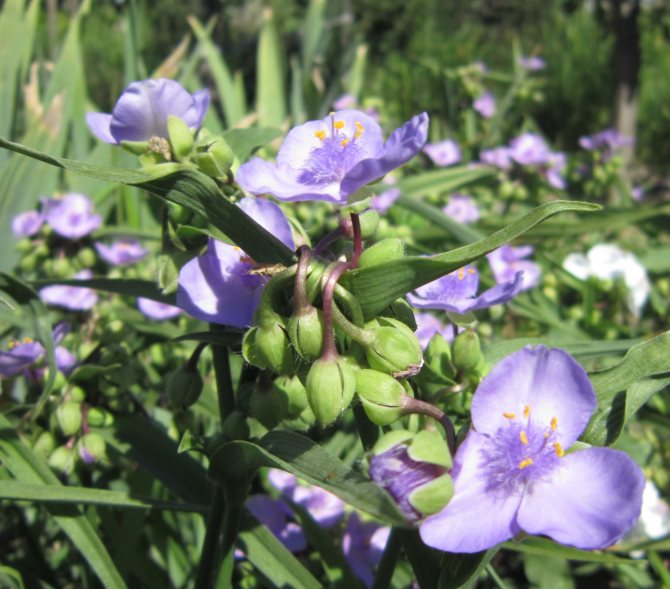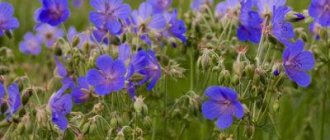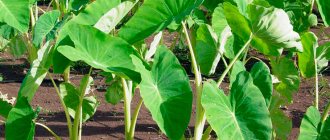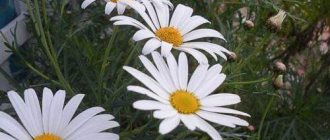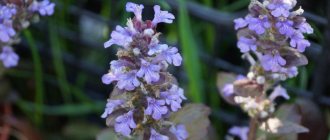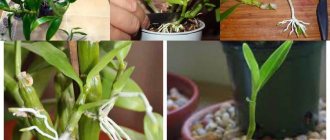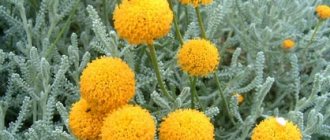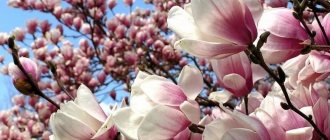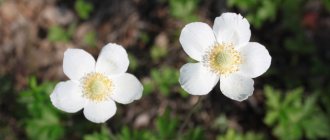»Flowers» Tradescantia Anderson - features of cultivation
0
57
Article rating
Tradescantia belongs to the herbaceous plants of the Kammelinov family. Her homeland is North America. The name comes from the botanist John Tradescant, who first described this flower. As a result of crossing the Virginia Tradescantia with two wild varieties, the Anderson variety was obtained, which can be grown in the open field and in apartment conditions.
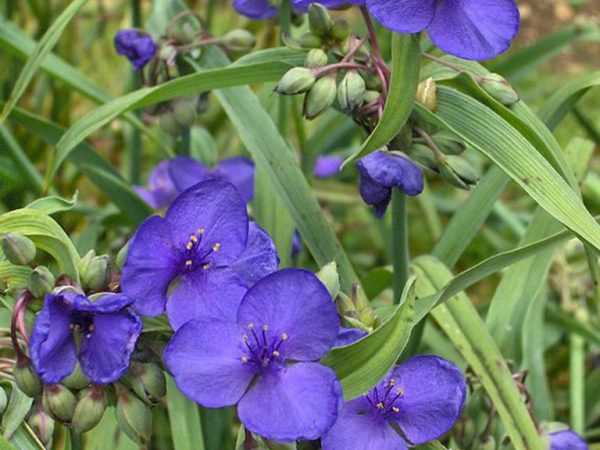
Tradescantia Anderson - features of cultivation
Description of the variety


The height of the Tradescantia plant can reach 1 m. The bushes are dense, form numerous branches, which are rather fragile in structure. Long green leaves grow up to 20 cm in length. The color of flowers is different: pink, purple, white or blue. Tradescantia blooms for 3 to 4 months, but each flower on the bush blooms for no more than one day.
The lifespan of one flower is only one day, but as soon as the faded buds are removed, new, more lush and voluminous ones appear.
Features of flowering tradescantia
Tradescantia is distinguished by abundant flowering, but the petals themselves will never be scattered inaccurately throughout the garden. In the afternoon, in the afternoon, in sunny weather, or in cloudy, but already in the late afternoon, Tradescantia flowers begin to curl up and disappear in their seed boxes, like snails in their shells. Thus, you can observe the mystery of the birth of the seed.
In their shape, bells with seeds and buds that have not yet opened resemble huge clusters. They are a complex plexus, so it is rather difficult to determine which "bunch" will turn into a beautiful flower with three petals the next morning. The main advantage, as mentioned earlier, is the long and continuous flowering of the garden tradescantia.
Important!
The decorative appearance is affected by the load by the end of the season, if you try to remove the already faded bunches each time.
Then from the leaves of the xiphoid shape, young flower stalks can appear already with buds, and the Tradescantia will again be abundantly covered with flowers with three petals.
Cultivation and reproduction


Garden Tradescantia is propagated vegetatively. To do this, you must separate the stalk from the bush and put it in the water. You can plant the cuttings in moist soil, and the roots will appear from it the very next day. Thus, the plant quickly takes root and will soon delight with lush bushes.
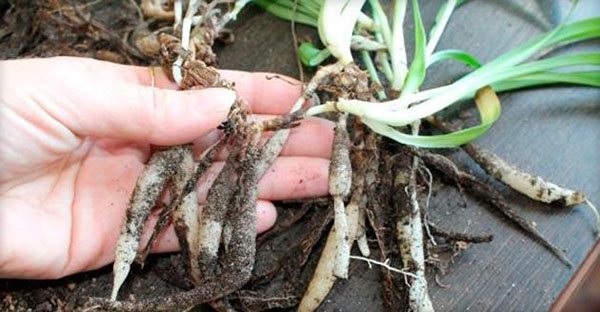

A variant of reproduction by dividing the bush is possible. To do this, it is necessary to divide the bush into equal parts and plant it in prepared moist soil. The roots of the plant are quite strong, so scissors can be used while dividing.
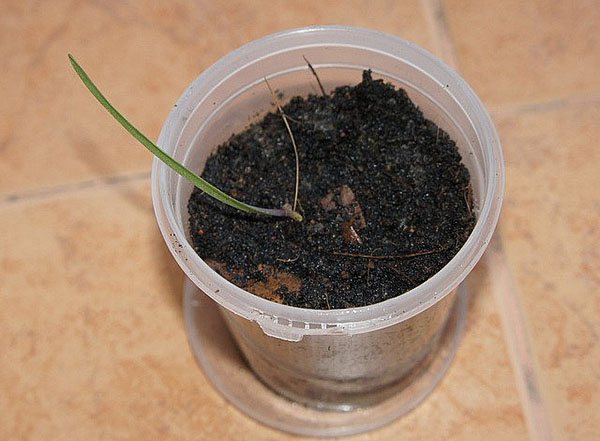

Often, Tradescantia is grown from seed, but when propagated in this way, it often loses its varietal characteristics. In order to grow a plant by seed, you need a well-moistened fertile soil. Sowing is done before winter, in the spring it will be necessary to perform a pick of seedlings.
Soil care
Garden Tradescantia loves a humid habitat, so care for and watering Tradescantia should be done very carefully. In the fall, watering Tradescantia should be reduced.
Soil composition for tradescantia:
- sod;
- humus;
- sheet;
- sand;
- or you can choose ready-made soil with good drainage.
Feeding with fertilizers based on a complex of minerals is carried out in March. You need to take 10-30 g of fertilizer per square meter, burying it in the soil to a depth of about 8 cm.
Subsequent feeding should be carried out twice a month using Kemira liquid fertilizer. After the peduncle fades, it is removed, and the plant is mulched with peat and covered with spruce branches.
Landing
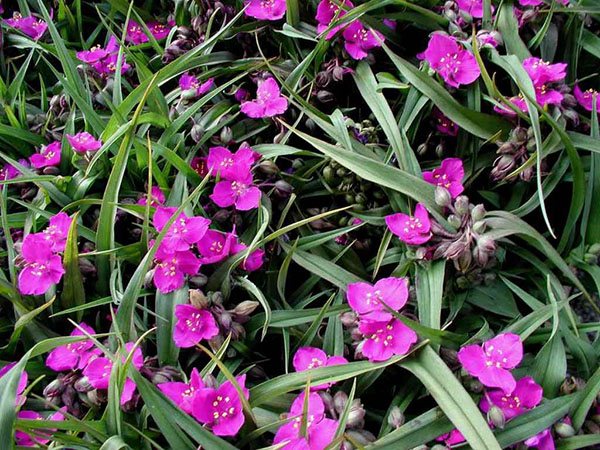

Proper planting and caring for Tradescantia consists of careful selection of the landing site. It is carried out in the prepared soil, in a place where the sun's rays regularly fall. The best option for such a plant would be soft sandy or drained soils.
Having chosen the right place for planting, the plant will delight you with lush buds.


The site for planting and further care for Tradescantia in the open field should be blind, it is important to protect the plant from strong winds. At the time of planting, you should avoid an area where moisture quickly leaves. Such soil will need moisture-retaining top dressing (clay, sawdust or compost). An excellent solution for growing a bush would be a place that is slightly darkened by trees.
It is worth taking into account: if you plant a plant in a heavily shaded area, then such bushes may not bloom.
Before planting, the soil is well fed with organic fertilizers. Humus, compost or humus are introduced. After planting, the bushes are watered abundantly, mulching with peat or humus is done.
Fertile soil will make it possible to prolong the lush flowering of Tradescantia.
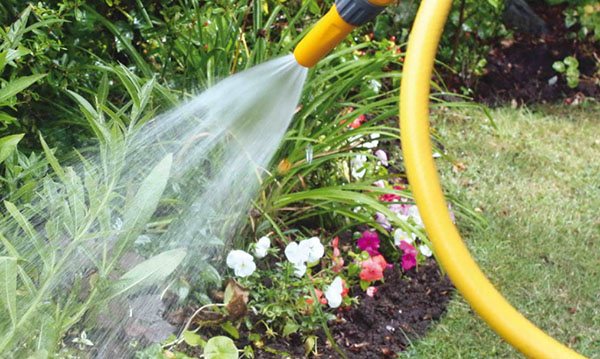

For the proper growth and development of the bush, the soil must be periodically moistened. If there is no rain for a long time, as an option, you can organize artificial watering.
With the onset of cold weather, frequent watering is stopped, it is carried out only when necessary. Providing the Tradescantia bush with proper care, it will delight you with lush and abundant flowering.
In addition to watering, the plant needs to be sprayed with leaves. It should be done in the morning or evening.


Caring for a plant involves regular feeding:
- The first feeding is done in the spring, but before that it is important to clear the plant of weeds. Fertilize with mineral fertilizers.
- The second is done in late spring (May, early June) using nitrogen fertilizer.
- The rest of the dressing is carried out regularly - once every 3 weeks, but only after loosening the soil. For this, you can use any complex fertilizers.
- As soon as the first buds appear on the bushes, the plant will need potash and phosphate fertilizer.
At each stage of growth, Tradescantia needs certain types of feeding.
Top dressing
Anderson's Tradescantia needs regular feeding. In this case, it blooms and develops better. It is necessary to carry out top dressing with mineral fertilizer for herbaceous plants, purchased in the store. For the first time after wintering, the plant must be fed literally immediately after the snow melts. Particular attention should be paid to the nutrition of the plant when it begins to bloom. During this period, it will be necessary to constantly water the flower with mineral complexes once every 10 days until the end of flowering.
Garden Tradescantia in landscape design
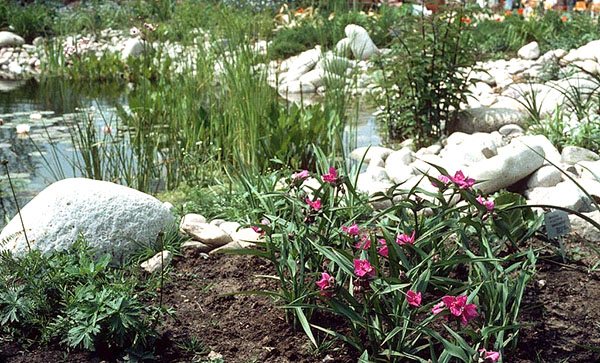

Garden Tradescantia is used in landscape design, because it looks great next to places for recreation. Such a flower is well suited for planting in flower beds, it can be located in any corner of the garden area. Even in the absence of scent, Tradescantia attracts butterflies, which fluttering around create a pleasant atmosphere, becoming a great addition to this composition.
Do not forget that the plant must be planted near water bodies.
Regardless of what sort of Tradescantia will be planted, any of them always looks impressive.There are many flowers on the bushes of the plant, which form bright dense clusters. The lack of smell is not a disadvantage, but on the contrary, does not attract bees and bumblebees. If you remove the already faded buds during the time, then new lush flowers will soon appear. In this way, the flowering of the plant can be prolonged and increased.
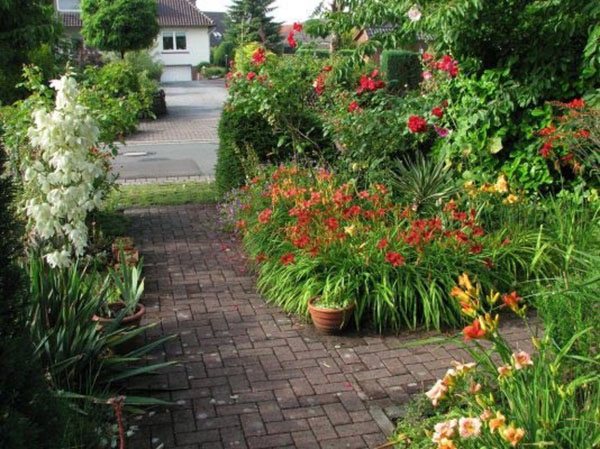

Garden Tradescantia has an abundance of varieties, thanks to which you can choose an interesting combination. Correct planting and care of Tradescantia will help avoid problems with the plant in the future. For example, to do without tying up each plant, the bushes must be planted back to back.


Tall varieties are sometimes troublesome to care for - they do not keep their shape well, especially after watering. Unfortunately, such varieties cannot do without tying, therefore, before choosing a plant, you should pay attention to this feature. If you plant bushes in dark places, they will also tend to stretch regardless of the variety, which means that a slightly shaded area or a place in the sun will be the best place for tradescantia.
To avoid tying a bush, summer residents recommend planting a hosta, brunner, swimsuit and similar plants close to the plant.
Low-growing varieties are planted next to lungwort and geraniums. Such herbaceous plants will not only become an excellent support for the bush, but also create beautiful compositions in the garden.
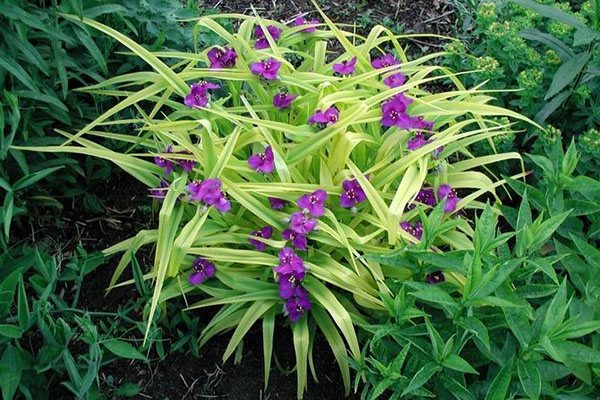

Planting Tradescantia next to other plants will not only decorate the appearance of the site, but also become an excellent support for the plant.
Anderson's Tradescantia


The tradescantia hybrid variety was bred by the American botanist Anderson. The experiments were based on Virginia Tradescantia. The hybrids obtained during the tests have a difference in the branching of a plant with straighter leaves. No more than 80 cm can grow in height, the color of the leaves is purple with a greenish tint. Flowers vary in color - from pink-purple to blue or even white. This type of plant is distinguished by larger flowers, which decorate the bush even more.
Anderson's variety has an abundance of different shades, one of the most popular is purple.
Planting and caring for Anderson's Tradescantia is a hassle-free process. The plant is unpretentious in care, it can be grown even by those who have never dealt with growing flowers. It is recommended to plant flower bushes in slightly shaded areas. The main rules in caring for a plant are compliance with regular watering and timely feeding. When all the manipulations are performed, the tradescantia bush will bloom from the beginning of June to the beginning of October.
The soil
The plant needs a soil with a weak acid composition, while being quite loose. Anderson's Tradescantia variety does not like dry and sandy substrates. Before planting, it is a good idea to enrich the soil with peat, which will retain moisture like a sponge. A little black oily clay and rotted sawdust will also come in handy. You can add compost, but it is undesirable to use fresh compost.
Sometimes a bush may need support. Especially after rain, it happens that the leaves and stems fall on the ground. Therefore, if your Tradescantia has long "limbs", either cut them or tie them up. Experienced gardeners try to find such neighbors for her so that the need for a garter disappears. These are, for example, hosts, swimsuits, astilbe. They will create a wonderful neighborhood for the plant, while supporting its leaves, preventing them from falling to the ground. In addition, with group plantings, Anderson's Tradescantia looks especially decorative.
Garden Tradescantia
Among flower growers of central Russia, the most popular species is the Virginia tradescantia and its garden hybrids. Graceful colorful flowers bloom for just one day, replacing each other throughout the summer, up to autumn frosts.If you are familiar with room tradescantia, then you probably know that the family got its name thanks to the discoverer - the gardener of the Swedish king, John Tradescant. The Virginia species is named after the place of discovery - the state of Virginia, USA, where more than 20 hybrids live.
This American woman has taken root well in our area, she is frost-resistant, and only in extremely harsh winters does she need a little shelter. After planting, the bushes quickly adapt and do not require special care. Also an undeniable advantage is the appearance of an overseas guest! Garden Tradescantia forms dense thickets of tubular stems with pointed leaves. By themselves, they look very picturesque and will decorate any garden. No wonder this plant is one of the favorites in landscape design.
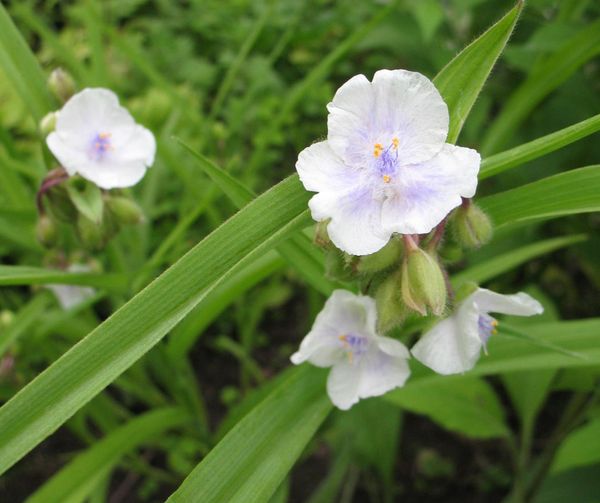

photo of the author
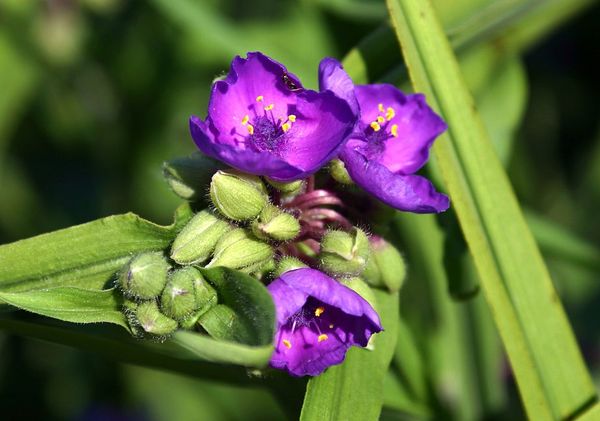

During flowering, you can observe a similarity with domestic species, because the structure of the flower is identical for all Tradescantia: small corollas of three petals with bright stamens. Only the shade differs, which is currently represented by a wide palette: from classic blue to white, pink, purple and even red. Each flower blooms for just a day, but Tradescantia is continuously forming new buds.
On a note In addition to decorative, this inhabitant of the flower bed also has medicinal properties. Its leaves can be used in place of plantain to stop bleeding from cuts and abrasions. To do this, a freshly cut leaf must be rinsed and, lightly rubbed until juice appears, applied to the wound.
A whole rainbow of these exquisite flowers can be grown within the garden! They look good both in a single planting and in a duet with other representatives of the garden flora: daylilies, hosts, irises, ferns, or ground cover species. Having adapted to the conditions, the bush can grow in one place for more than 10 years.
Among Tradescantia, there are not many species that can be grown outdoors. Another weather-resistant species is Anderson's Tradescantia. In fact, it is a hybrid obtained by crossing the Virginia variety and two "wild" - forest species. It is believed that Anderson's variety is even more resistant to freezing. The name of the flower was given by an American botanist who studied it. However, outwardly, this hybrid can only be distinguished from the “parent” by the keen eye of a botanist, because at first glance they are very similar.
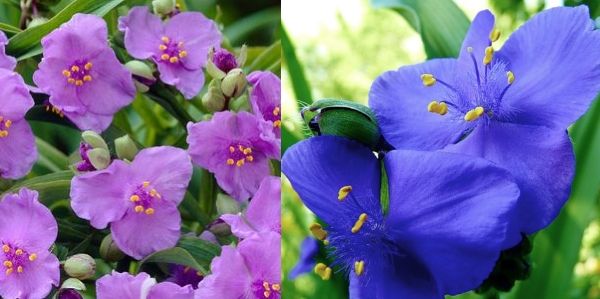

t. Anderson and Virginskaya
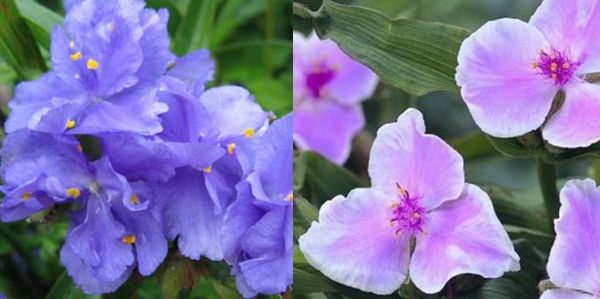

T. terry and pink shablis
Garden Tradescantia, a photo of which can hardly convey the beauty of this flower, also has terry hybrids with several petals among its varieties.


Fight against possible diseases and pests
There are times when gardeners think about why the leaves of Tradescantia turn yellow. To determine the cause, you need to regularly inspect the flower, as ticks and a scabbard can start, which will suck the juice from the plant, which will soon cause its death. Leaves can dry out and turn yellow at low air humidity.
This insect reaches 4 mm in length and looks like a small plaque attached to the lower leaf along the veins. The color is very variable - yellow, red, brown. Leaves are covered with heels, then turn yellow and fall off. Also, sticky discharge from leaves and shoots can be ranked as signs. The pest loves to eat this juice. Removal of the scabbard is carried out with a rag soaked in soap or alcohol solutions. If the plant is very heavily infected, then you need to treat it with Karbofos, Fufan or Aktellik.
If these methods do not help, you need to prune the most affected parts of the plant.
Tradescantia is a variety of herbaceous plants from the Kommelin family. It began to be bred in the 17th century by John Tradescant, the gardener of the English king Charles I.Many years have passed since that time, and now the plant has gained immense popularity. Several generations of breeders have worked to create the variety of Tradescantia. Today this plant is often used in landscape design.
Care rules
Until recently, this plant was a rarity, but now we have the opportunity to grow it on our site.
Tradescantia garden planting
There is a place for this exquisite flower in any garden: thanks to its unpretentiousness, the choice of a site for planting is very wide. On the shore of a reservoir, or on a flower bed, at the foot of a fruit tree, or at a house - she will be comfortable everywhere. However, garden Tradescantia will feel best in partial shade. In bright sunny areas, the plant will be constantly thirsty, and the flowers will wither faster.
Any fertile, slightly acidic soil without stagnant water is suitable for the plant. Although Tradescantia belongs to the category of water bites, its need for moisture can be compensated for by regular watering. Before planting, it is better to prepare the soil in advance so that the bush will quickly take root and begin to bloom. When digging a site, you can add a complex mineral fertilizer and add humus, or compost.
The flower is propagated by seeds, cuttings and dividing the bush. For a Tradescantia plant, garden planting of seeds in open ground is permissible already in April, they firmly tolerate residual spring frosts. To obtain seedlings, it is best to sow them in greenhouses in early March, and in May, grown bushes can be planted in a permanent place. Experienced gardeners practice propagation by cuttings and dividing the bush, all procedures are performed in the spring, or early autumn. It is useful to practice dividing the bushes so that they do not grow outside the flower beds. Every 3-4 years they are cut into large pieces and seated. Young green shoots with two or three internodes are suitable for propagation by cuttings. They are usually rooted in water or wet soil. Planted in the summer, they will survive the winter safely under light cover.
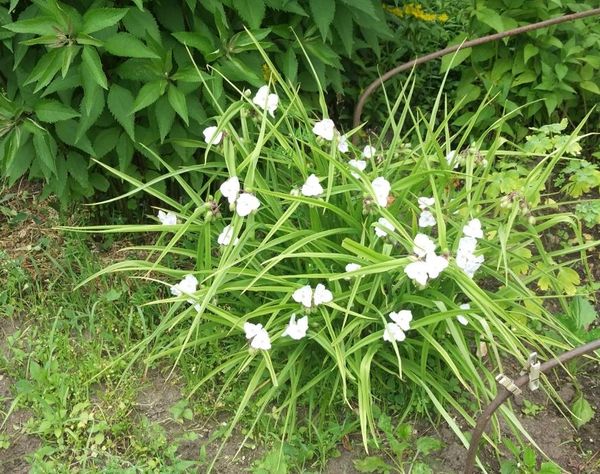

Garden tradescantia care
Garden Tradescantia is moisture-loving, therefore it needs regular watering, especially during dry periods. Plants planted in partial shade do not need moisture as much as those growing in sunny areas. In the second case, it will be useful to mulch the base with dry straw or mown grass: mulch will retain moisture in the soil, preventing it from drying out quickly. Mulching plants.
Choosing a place to plant Tradescantia in the garden
It is best to choose a not too sunny area as a landing site.
The best for tradescantia is partial shade and the presence of a reservoir in the garden. Soil for Tradescantia should be chosen fertile, light and slightly acidic. The flowers of the plant are short-lived, so the shade will be excellent options for planting and further growth.
Important!
Drought will cause the death of the plant.
Tradescantia in drought conditions will stop blooming and will need constant spraying with water. These procedures are best done in the evening.
Growing problems?
This spectacular "foreign" is unpretentious, winter-hardy, not susceptible to the invasion of garden pests. It blooms profusely and rarely gets sick. The plant's condition is influenced by the choice of planting site and climatic conditions.
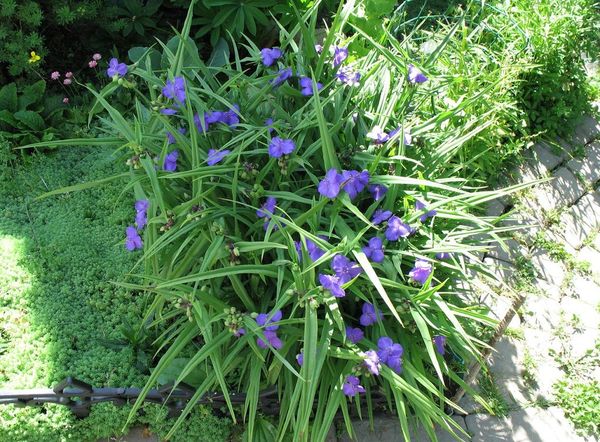

- If the flowers and leaves of a Tradescantia dry up ...
This problem is observed in plants planted in an area that is under the midday sun. Although the plant has dense leaves, it cannot be classified as a drought tolerant succulent. The lack of moisture greatly affects the appearance: the leaves lose their color brightness, the flowers dry out quickly. A long drought can even kill the Tradescantia bush!
- If there are stains on the leaves of Tradescantia ...
All kinds of stains and plaque on leaves and flowers are a consequence of garden diseases, most often fungal.This is confirmed by brown leaf tips, dark spots, or plaque on the leaf surface, deformation of flowers and buds, lack of flowering and growth retardation. Even the strong immunity of Tradescantia garden can fail in conditions of constant dampness and coolness, especially if the plants adjacent to the flowerbed have already become victims of a fungal "epidemic". But this kind of ailment is treated with fungicides!
Although Tradescantia garden loves moist soils, stagnant water is not to her liking even to her. Therefore, in the lowlands, it is better to create an artificial hill on which the bush will be protected from excess moisture.
Support our site, share the link on social networks. Thank you!
Flowering tradescantia
Tradescantia blooms profusely, but you will never see the messy scattered petals around the blooming Tradescantia. In the afternoon, in sunny weather, and in cloudy weather, in the late afternoon, the flowers of this plant curl up and, like fearful snails, hiding in shells, disappear in the seed pods to complete the sacrament of the birth of the seed.
In shape, "bells" with seeds and unopened buds are similar in clusters, so mixed with each other that it is rather difficult to guess which of the emerald balls will turn into a three-petalled flower the next morning. Long, abundant and continuous flowering is the main advantage of the garden tradescantia.
Such a load affects the decorative effect of the bush by the end of the season, if you remove old faded bunches from the Tradescantia, instead of the axils of the xiphoid leaves, young peduncles with buds will appear very quickly and the Tradescantia is again abundantly covered with three-winged moth flowers.
The best varieties


There are about 10 varieties of garden tradescantia. And all of them are in demand by flower growers and landscape designers not only in our country, but also in many European countries. This climbing plant is recognized by flower growers and is actively used in decorating plots, parks and squares. The unpretentiousness of hybrid varieties and their long flowering are the main advantages of Tradescantia.
| Variety name | Latin name | Description of shoots | Description of flowers |
| Tradescantia striped | Tradescantia Zerbina | Central America, the length of climbing shoots is up to 0.8 m, foliage is located on the shoots alternately, their length is up to 0.1 m in length | Flowers - three-petal, shades vary from violet to lilac and pink |
| Covering grade | Tradescantia spathacea | Plant - herbaceous, wedge-shaped foliage, often located on the stem | |
| The variety is thick | Tradescantia crassula | Brazil. The plant is creeping, the length of the stems is about 0.8 m | Foliage - tubular, due to its large size, it needs to allocate a lot of space in the room |
| Riverside Tradescantia | Tradescantiafluminensus | forests of Brazil along the river banks. Foliage is reddish or purple in color | Flowers up to 1 cm in diameter, three-petal, bright white |
| Virginia Tradescantia | Tradescantiavirginiana | The place of growth is the state of Virginia, USA, as well as in the east of this country. Foliage elongated | Small flowers, colors from white to lily |
| Tradescantia Anderson | Tradescantiax Andersoniana | A hybrid variety with a variety of green to purple to light yellow vegetative | The flowers are mainly three-petaled with a shade of petals ranging from pink to lilac and blue |
| Tradescantia white-flowered | Tradescantiaalbiflora | The shoots of the plant are not standing, but creeping, foliage is smooth, light green | The flowers are not large, bright white, with three petals |
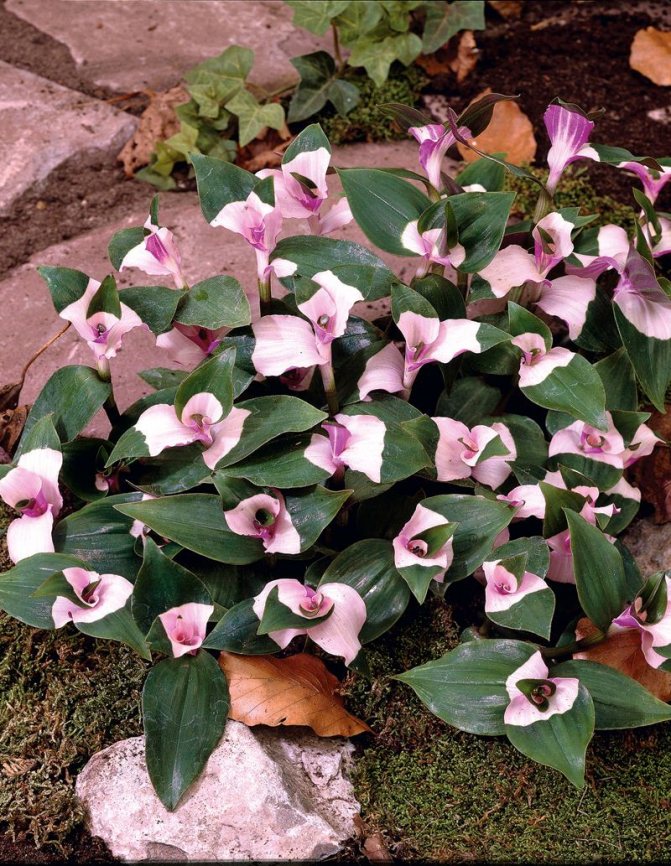

Tradescantia Virginia Rosea


tradescantia and my beloved passionflower
Varieties
Anderson's Tradescantia has many varieties, the most popular of which are:
- Macs Double (Max double) - blooms with enlarged bright lilac flowers.
- Innocence (Innosens) - has snow-white flowers with a lilac center.
- Red grape (Red Grape) - flowers are bright purple, and its leaves have a silvery tint.
- Billberry Ice (Ice bilberry) - lavender flowers with white edges, green foliage.
- Pink Joy - lilac-pink flowers and white-green striped leaves.
- Merlot Clusters - has blue flowers and green foliage.
- Karminglut (Carminglut) - blooms with crimson flowers with silvery leaves.
- Osprey (Osprey) - has pale blue flowers and green leaves.
Basic planting and grooming requirements
All hybrids of garden tradescantia are adapted for planting in open ground,
they are unpretentious and undemanding. However, you should not plant these creeping shoots in the open sun.
Shaded areas are best suited for planting.
It is here that the beautiful lush bushes of Tradescantia grow. Watering should be regular, but not plentiful, otherwise the plants will water. Under the open rays of the sun, the flowers quickly wither and fall off.
And only the variegated species of this plant thrive in the open sun. But in the shade, they lose the brightness of the color of the foliage, fade and fade. The most suitable temperature regime for tradescantia is from 13 ° C to 24 ° C.
In the hot season, the plants are watered more often, but there should be no stagnation of water in the ground. During cooler seasons, the amount of watering is reduced. Tradescantia can withstand drought for a long time, but this adversely affects the flowering and brightness of the foliage color.
In one place, this perennial plant feels good for several years, without needing a transplant.... Therefore, the beds for these flowers are prepared in advance, saturating them with organic fertilizers (manure, humus or compost).
Where to drop off
Anderson's Tradescantia thrives in shaded areas. It's great, because there are many flowers that love the sun, but a flower garden in the shade sometimes becomes a problem.
Take advantage of the experience of experienced florists and plant this plant so that there is a tall tree or bush next to it, on the south side.
Thus, you will protect the plant from the burning midday rays of the sun. Keep in mind that flowers will fade quickly in the sun. Blooming Tradescantia will turn the flower bed into a corner where it is pleasant to be in the summer - beautiful, cool, calm.
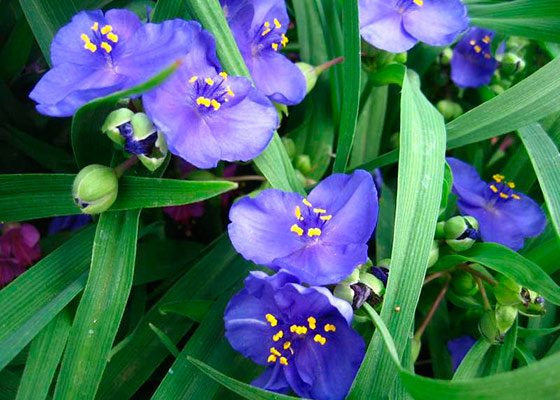

As for the soil, you will need fertile soil abundantly fertilized with humus. On hot days, water Andersen's Tradescantia very abundantly, especially since its homeland is the tropical forests of South America.
If there is a pond on your site, then Anderson's Tradescantia will bloom on its shore from June to September. For example, it will be the Bilberry Ice variety - lavender flowers with a white border. The landscape will be amazing.
Cut off an adult plant in the middle of summer, thanks to this, the flowering will become more abundant, and flowers will appear on young shoots in the fall. At this time of year, they will also look amazing in the flower bed.
Tradescantia: growing in the shade (video)
Tradescantia grow beautifully next to water bodies, but you should not grow them directly on the shore of a water body - a pond or lake. These decorative flowers will adorn any shore. But they shelter them for the winter only if a cold winter without snow and with strong winds is expected.
The beds are preliminarily cleaned of weeds and debris, saturated with rotted organic matter and shallow furrows are prepared for planting tradescantia. Their depth depends on the size of the plant's root system. In the grooves, organic matter is mixed with the soil, watered, and only then these weaving plants are planted. After planting, the plants should be watered again, and covered with peat or dried grass on top, so that less moisture leaves the soil.
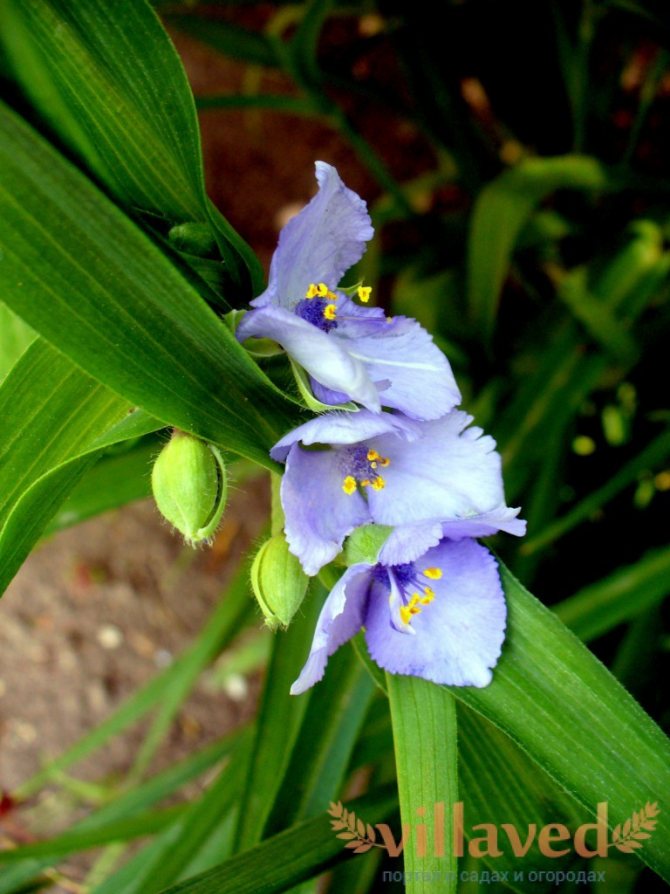

tradescantia virginian
Tradescantia does not require special care.
In the spring, they should be fed with complex mineral fertilizers, watered, loosened the soil so that a dry crust does not form, which prevents oxygen from entering the ground. All weeds are removed at the same time.
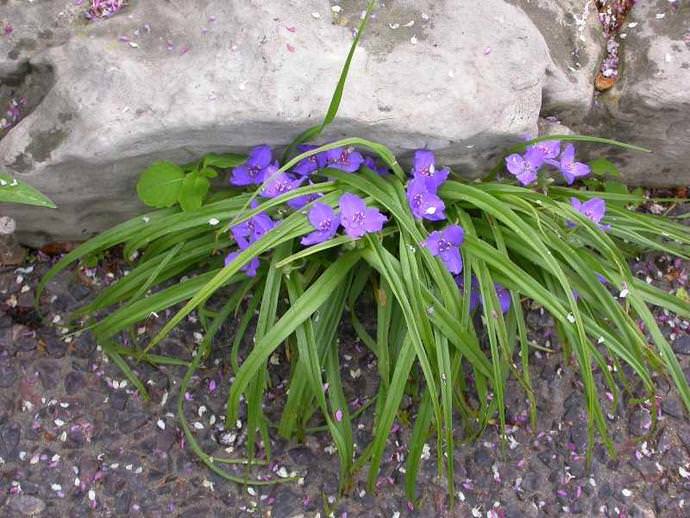

In one place, this perennial plant feels good for several years, without needing a transplant.
If the plants are tall, then they should be tied to special supports so that the plants will not be broken by strong winds. In autumn, Tradescantia is cut almost completely, and mulched with peat on top to protect it from cold snaps.
When growing tradescantia at home, special attention should be paid to watering. The main thing is that water does not stagnate in the soil. To prevent this from happening, a layer of drainage material is laid out on the bottom of the pot or flowerpot. Watering tradescantia is carried out with warm settled water at room temperature.
In hot weather, the plants are sprayed with a syringe every day. There are no other requirements for environmental humidity.
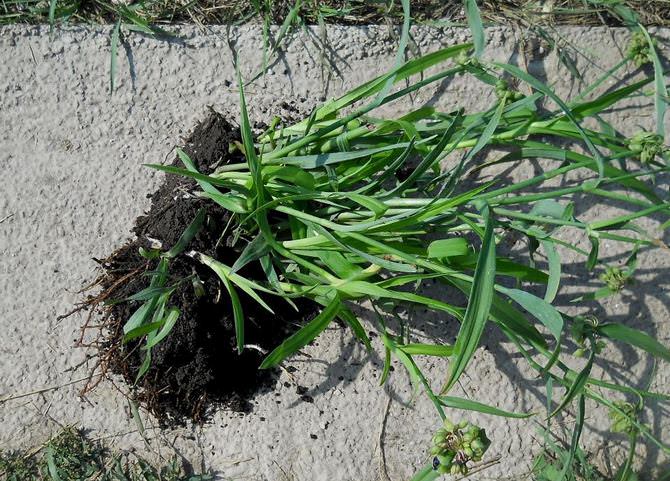

This plant is propagated vegetatively in order to preserve the main characteristics of the variety.
Country of origin of tradescantia
Tradescantia - home care
The natural habitat of this plant is considered to be the temperate and tropical zone of the USA. From northern Argentina to southern Canada, there are about two dozen species.
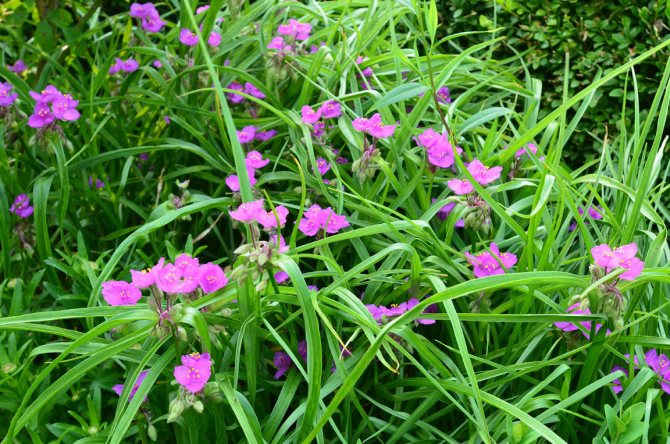

Virginia Tradescantia
The flower got its name in honor of the father and son of the Tradescants, who were collectors, travelers and naturalists. For one of the popular species (Virginia Tradescantia), the country of origin served as the starting point for creating a poetic name.
Reproduction methods
You can plant these flowers both by seeds and vegetatively.
Tradescantia is grown by seed only to select new plants with unusual shades of flowers or foliage. But this plant is propagated in a vegetative way in order to preserve the main characteristics of the variety.
Usually, those plants that have lived for two seasons are divided. These plants have already grown several stems. Cuttings are cut so that each has 2 - 3 nodes with leaves. Cuttings are planted in boxes with coarse river sand at an acute angle to the soil, burying one knot in the sand, the foliage from which is cut off.
The plants are watered constantly, but not abundantly. After 20 - 25 days, the cuttings develop a root system. In this case, the plants can be transplanted to a permanent place.
Andersen's Tradescantia
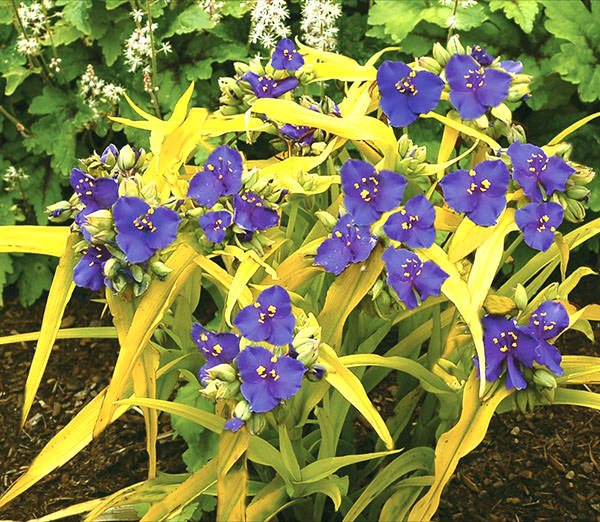

covered tradescantia
Cited 1 times Liked: 2 users
54
Types and varieties of tradescantia
Currently, amateur florists are offered a whole gallery of beautiful varieties of garden tradescantia. Hybrid tradescantia have large flowers (about 5 cm in diameter) of various colors: snow-white - "Little white doll
», «
Snowcap
», «
Innocence
"; raspberry - "
Karminglut
», «
Rubra
», «
Satin doll
»,«
Red gloud
"; rich lilac - "
Purple profusion
», «
Lord nelson
», «
Zwanenburg Blue
"; lavender blue - "
Little doll
», «
Blue stone
», «
True blue
», «
I.C. Wegueelin
"; pale pink - "
Charlote
», «
Perrine's Pink
"; dark blue - "
Leonora
», «
Valor
», «
Isis
».
Tradescantia flowers can be two-colored or with contrastingly colored "puffs" of stamens: "Billberry ice
», «
Pink chablis
», «
Osprey
". And the varieties “
Mac's Double
"And"
Caerulea plena
»Double flowers with intricately twisted petals, reminiscent of small blue-blue lambs! Foliage of tradescantia can be silvery green, dark green, bluish blue with purple outlined contours, golden yellow - an amazing contrast of large cobalt blue flowers and sunny foliage!
The garden tradescantia grows on the site, planting and caring for which is quite simple
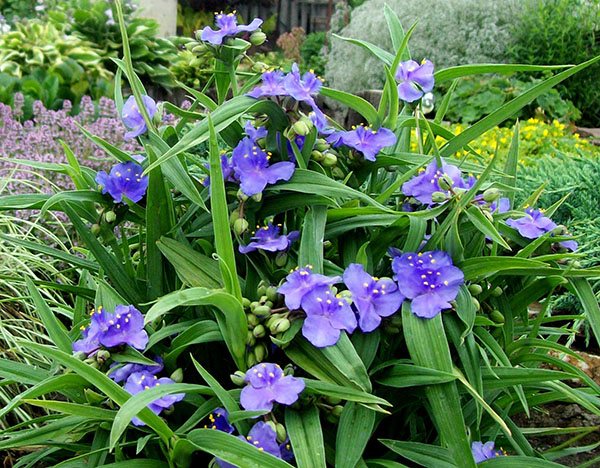

A perennial herb - garden tradescantia, planting and caring for which is absolutely not troublesome, many gardeners try to plant. The plant has gained considerable popularity due to the abundance of various varieties, which are often used in landscape design. Diverse varieties allow you to choose the most non-standard combinations of different colors, which decorate any area.
Tradescantia garden bushes help to create beautiful volumetric thickets in the garden area.Such bushes are planted close to ferns, daylilies, irises. Tall perennial varieties are recommended to be planted in summer cottages, in gardens near water bodies.
landing and leaving hosts!
Reproduction of tradescantia
In the same place, Tradescantia can grow for a long time, the bushes of this plant have compact growth and are not considered garden aggressors. Old plants bloom worse, so they need to be divided and rejuvenated every 5 years. The best time for this is spring, when young shoots appear.
You can also divide the bushes in August. Tradescantia is often propagated by stem cuttings, which take root easily after 2 weeks, not only in a greenhouse, but even in a cup of water. Cuttings can be carried out throughout the season.
Seed propagation of tradescantia is also possible, but usually varietal characteristics are not preserved.
Tradescantia is one of the most beautiful garden plants that blooms from May to September. The flowering of one inflorescence is short-lived, but since there are many of them, the bush always looks lush.
Growing Tradescantia
The plant is a small ornamental shrub 50-60 cm high. The color of the flowers may vary slightly, this may be influenced by the location of the plant, lighting and soil. This is a decorative, frost-resistant, unpretentious plant to care for. Diseases and pests (other than slugs) do not damage Tradescantia. Long bloom, from June to frost.
Place and soil for growing Tradescantia garden
Choose a site for planting Tradescantia garden not sunny, partial shade, preferably near.
The soil for growing Tradescantia should be fertile, light and slightly acidic.
Planting Tradescantia Garden
If you plan to plant Tradescantia with seeds, then sow in March-April (flowering will begin at 3 years), if in dealers, then in early spring or autumn.
For planting by cuttings, cut a stalk with leaves, place it in water and you will soon see roots. Transplant into the ground when the roots are 2 cm long.
Preparing phlox for the winter with a shelter
Phlox is a relatively frost-hardy culture that can hibernate without shelter, growing in a mild continental climate. But even during warm winters, there are short-term strong cold snaps that can destroy the buds and roots of a plant: the fatal temperature for the aboveground part is -15 C, for the underground part -20 C.
Not only severe frosts, but also long thaws are dangerous for perennials: the plant reacts to heat and quickly dissolves buds, which suddenly freeze after the resumption of subzero temperatures. To protect the buds from possible frosts and prevent them from blooming during a period of short-term warming, plantings must be covered. Phloxes, which do not have good cold resistance, as well as recently planted plants that have not yet matured, are especially in need of mulching. Covering phloxes before winter is very simple: flowers prepared for winter are covered with a 10 cm layer of peat, compost or humus. In order to insulate one plant, it is necessary to scatter about one bucket of mulching material around the perimeter of the root system. In order for the snow to linger longer over the bush, the mulch is covered with spruce branches, large tops. The shelter must be removed in early spring, as soon as the risk of severe frosts disappears.
Tradescantia is one of the most beautiful garden plants that blooms from May to September. The flowering of one inflorescence is short-lived, but since there are many of them, the bush always looks lush.
Disease prevention and protection against phlox pests
White spot. This phlox disease manifests itself on the leaves in the form of dark brown, rounded spots with a dark red border, which gradually increase and begin to merge with each other. The affected leaf tissue dies off, the leaf dries up and falls off.At the first signs of the onset of the disease, phlox bushes and the soil around are sprayed with a 1% solution of Bordeaux liquid. Spraying is repeated after 10-15 days. For prophylaxis in the fall after freezing of the soil, it is recommended to cut and burn stems with leaves.
Formos. In affected phlox, the leaves turn brown and dry out. Control measures are the same as for white spot. With verticillary wilt, outwardly healthy stems wilt without yellowing of the leaves on them. Myceliums are formed on the surface of diseased roots. This phlox disease is more common on acidic soils and in waterlogged places. Liming of the soil, destruction of plant residues is necessary. In the spring, phloxes are sprayed with a 1% solution of Bordeaux liquid, and the roots of diseased phloxes are immersed in its 0.5% solution for 15-20 minutes and planted in a new place. The hole from which the bush is selected is treated with copper sulfate.
Mosaics, crushing leaves, curly leaves, variegated flowers, double flowers are viral diseases. Control measures: immediate destruction of infected phlox.
The threadiness of the leaves is one of the most dangerous viral diseases. Affected plants grow poorly, form short, fragile shoots with narrow, threadlike leaves with wavy edges, do not bloom and in most cases die quickly. The most susceptible varieties are Sasha, Bely Biryulevsky, Elfenkönigin, Krasa, Lyubasha, Ernst Immer, Yubileiny and others.
Variegation - poses a particular danger to large collections of phlox, as it is transmitted with pollen, sap and seeds of diseased plants. The disease is dangerous because the affected phlox eventually lose varietal characteristics and all become equally "motley". The disease is characterized by the appearance of radial stripes of a lighter tone on the flower petals. In contrast to the homogeneous symmetrical pattern of genetically variegated varieties, diseased phloxes have an asymmetrical pattern in which pale stripes-sectors expand towards the edges of the petals.
Fresh articles about garden and vegetable garden
Popular species in floriculture
T. virginskaya (lat.T. virginiana). At home - in the temperate climate of North America - grows in thin forests, meadows, near roads. It develops well on nutritious, light, loose and moist soils, does not like sandy soils. The height of the bush is up to 80 cm. Green lanceolate leaves sit on knotty shoots. The petals are pink-purple, occasionally white, 2 cm long. There are also varieties of Tradescantia with blue, pink, red flowers.
The plasticity of the Virginia tradescantia allowed it to quickly adapt to the temperate climate of Asia and Europe. For more than a decade, T. Virginiana can grow in one place, not growing much in breadth. This feature is widely used to form flower arrangements and mixborders.
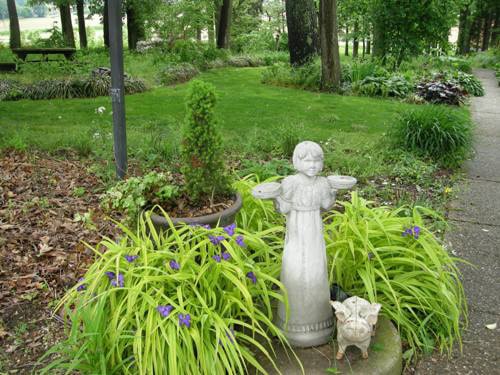

Framing the statue with Tradescantia
T. Anderson (lat.T. x andersoniana). American botanist William Anderson carried out work on the creation of garden hybrids, based on Virginia Tradescantia. To date, thanks to his contribution to the creation of open ground tradescantia, all the hybrids he obtained have been combined into a species - T. Anderson.
A bush with branched, erect, leafy stems, can reach a height of 0.8 m. Leaves are violet-green. Corolla color is varied: white, pink, blue, purple.
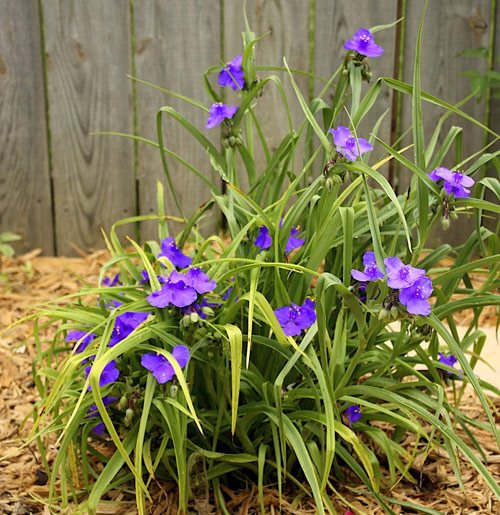

Bush with garden Tradescantia flowers
Most of the literary sources T. x andersoniana and T. Virginiana are presented as synonyms.
T. blue (lat.T. Coelestis). Often cultivated as a seasonal annual. In the fall, the formed tubers are dug up and stored in a cool place, and in the spring they are planted in a flower garden. Due to their low growth, up to 50 cm, powerful erect bushes of plants are used for composing compositions in containers.It blooms in August - September with bright blue, azure and purple inflorescences.
Photo gallery of views
Diseases and pests
The plant is not afraid of pests and diseases. You should only be afraid of slugs and some beetles. In addition, there have been cases of tradescantia being affected by the strawberry nematode. The root, stem, leaves, flowers and even the seeds of the plant may be affected.
When a strawberry nematode is affected, the leaves are covered with dots of light green or yellowish color, slightly wrinkled. Then the leaf dies off, with a strong defeat, whole shoots dry out. The aerial part of the plant that has suffered from this pest must be removed. Marigolds and cruciferous crops (watercress, mustard, etc.), which can be sown next to Tradescantia, will help clear the soil.
Tradescantia: description, properties
Garden Tradescantia is a thermophilic plant that is known throughout the world as an indoor plant. However, some of its varieties are quite often grown in the garden as an ornamental decoration. Garden Tradescantia is a small plant (usually no more than 0.5 m in height), presented in the form of a bush covered with many lanceolate leaves and neat small flowers of pale purple, white, blue or pink.
Despite the short "life" of flowers (each "batch" lives no more than 1 day), the plant is always covered with lush inflorescences that adorn it for a record long time: from the end of spring until the onset of the first frost.


Tradescantia can be grown not only in the room, but also in the garden
Garden tradescantia (most often Virginia) is successfully grown as a decorative decoration for mixboards, shady flower beds, ponds, etc.
Advice. When creating decorative flower arrangements, several points must be taken into account. Firstly, it is important to maintain the height ratio of different plants: they should not cover each other, but complement each other.
Tradescantia can be placed near a fence in the shade or, for example, near fresh water bodies, where it will feel just fine and at the same time complement other, less ornamental plants living near the water.
Few people know about the healing properties of Tradescantia, thanks to which this plant becomes more than just a decorative ornament. So, for example, it can be used in the following cases:
- For the treatment of mechanical damage to the skin. The plant has a pronounced antibacterial / hemostatic effect: just apply washed and carefully mashed leaves to the wound.
- For the treatment of colds. You can prepare a valuable decoction from the leaves of the plant and rinse the nasopharynx with it several times a day. This will help eliminate a runny nose, cough.
- For the treatment of gastrointestinal diseases. Tradescantia is excellent for normalizing the functioning of the digestive system and eliminating an acute inflammatory process in the stomach.
- For the treatment of dental diseases. With the help of tradescantia, for example, periodontal disease can be cured: you just need to chew a small leaf before and immediately after eating.


Tradescantia has medicinal properties
Growing conditions
For novice gardeners, there is no more acceptable plant than garden tradescantia, the cultivation of which is not difficult. The plant is unpretentious to care for. Both sunny and shaded places are suitable for her. But only the most favorable conditions and proper care will ensure abundant and long-lasting flowering.
Since a flower can grow in one place for a long time without transplanting, it is necessary to carefully consider the choice of the site and prepare the soil. The best option would be a place that is illuminated by the sun both in the morning and in the evening, but at the same time slightly shaded by trees at noon. In this case, the plant will delight with open flowers throughout the day.
The location of the bush in a sunny place is also allowed, but it will be possible to observe the open flowers only until noon. The dense shade is not a suitable place for Tradescantia, which grows poorly and blooms under such conditions, and may even die.
Features of the
Tradescantia belongs to the genus of perennial grasses, belongs to the Kommelinovye family. This beautiful creeping flower got its name thanks to John Tradescant, the gardener of King Charles I of England. Back in the 17th century, this plant won the sympathy of royalty, so Tradescant diligently began to breed this plant with bright flowers and lush vegetation. Tradescantia is a vines from the tropics of America. It has taken root well in Europe as well, here it is grown indoors or in gardens. This was made possible by selection.
The resulting hybrids are able to grow at not very high temperatures. Street tradescantia bloom in May and delight the eye before the onset of a cold snap. The leaves of the plant are oval in shape, and the height of the garden bushes usually does not exceed the half-meter mark. They are covered with flowers of white, pink lilac, red and blue. Their structure is the same as that of domestic counterparts: 3 petals, against the background of which bright stamens stand out.
Although the flower's lifespan is short - 1 day - they appear over and over again, so the bush always looks beautiful.
19
Phlox transplant in the fall
These plants can be planted or transplanted in late spring, early autumn and even summer (but not in hot weather).
In autumn, it is impossible to be late with the transplant due to the fact that the plants do not have time to take root well before the onset of frost and die. Transplanting phlox in the fall is most favorable in the period from the last decade of August to mid-September, it is then that renewal buds are laid on the rhizome near the stems. In autumn, phlox should be planted with stems, but inflorescences and clusters with seeds should be cut off.
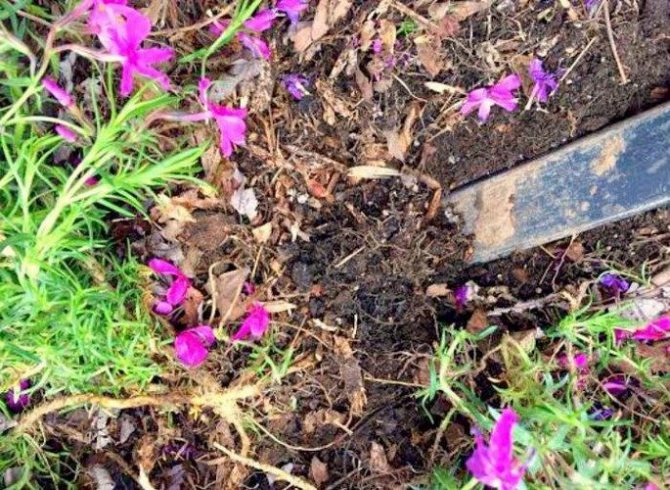

Late spring planting is fraught with the rapid onset of hot weather, which will also prevent phlox from developing well. Therefore, it is necessary to get down to business as soon as the ground thaws and is suitable for field work. Finally, if you still need to transplant phlox in the summer, then this should be done on a cloudy day, and you need to transplant the plant with a large clod of earth.
The basics of composition: who to choose her as a neighbor and where is it better to plant Tradescantia
Some varieties of poorly shaped bushes, especially vigorous ones, can create problems in flower beds - the plant lodges after abundant watering and rains. The looseness and shape of the Tradescantia bush can also affect the planting site: in a dark place, the shoots lose their stability and stretch out. The best landing place for Tradescantia is openwork light partial shade.
In such a place, Tradescantia flowers are larger, brighter and last longer than in a sunny place, and the bushes do not lose their compactness. If necessary, tie the Tradescantia to a support, and there is now a large selection of these convenient devices on sale for garden plants. You can do without "crutches", you just need to successfully pick up "neighbors" who will create a natural support for Tradescantia.
For example, you can plant astilbe, hosts, anemones, swimsuits, brunners, astrantia nearby. To undersized ones - geykhera, marigolds, low varieties of the same host and astilbe, geraniums, cuffs, variegated sedges, lungwort, gravilata. These plants will not only support Tradescantia, but with their spectacular leaves and inflorescences in color and shape, they will create wonderful compositions and will well emphasize the dignity of partners.
A great place to plant Tradescantia in the garden - by a pond or stream. In such places, high air humidity has a good effect on plant health.Tradescantia can also be grown in other flower beds: in mixborders, in flower beds, in rocky gardens, naturalized corners of the garden, and in other flower arrangements.
Tradescantia flowers are odorless, but they are good honey plants and a large number of colorful butterflies are always used as additional decorations for garden plants.
How to prune phlox in the fall
The procedure for cutting off the branches of flowers, experts recommend to be carried out from the 20th of September to 30 October inclusive. Of course, these are approximate dates, but it is necessary to finish with pruning before the onset of frost. The issue of pruning or not pruning the stems with leaves in phlox is not discussed. This should be done for prevention purposes. Leaf pruning can be done in two ways. Cut off the stems to ground level, or leave hemp with leaves up to 5-7 cm. They will help trap snow, which will have a beneficial effect on the plant. In the southern regions, they will provide flowers with moisture, and in areas with cold winters, it will help protect them from freezing.
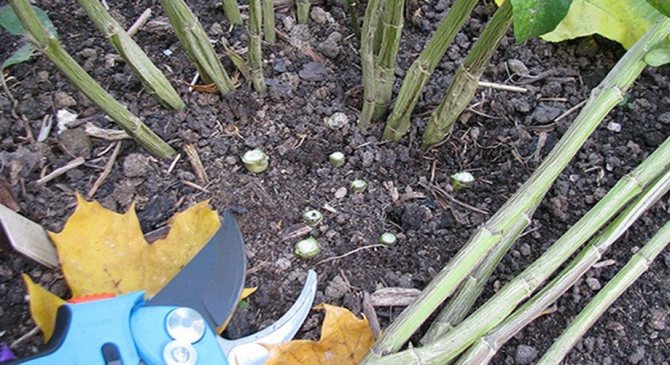

If your bushes are not sick with anything, then do not throw out the cuttings from them, it is better to let them go to the shelter of peonies and lilies. Well, if you doubt their purity, then the cut shoots should be burned, the spread of plant diseases is useless for you.
It is possible that spores of fungal diseases remain on the leaves. The leaves could be infected with nematodes, only fire can cope with them. Fight! If you feel sorry for the plant, then you will have to fight with nematodes for more than one year. Because they can easily move around the site. It is better to dig up and burn the phlox, you can save a sick plant if it is a very rare variety and it is not a fact that you can cure it, and then go out and return the plant to its former appearance.
Description of the plant
An adult plant looks like a small bush with a height of 0.2 to 1.00 meters with a large number of small beautiful flowers of white, blue, pink, lilac or purple color.
- The leaves of tradescantia are mainly bright green, lanceolate-elongated, with a regular arrangement. There are varieties with purple, yellowish or bluish foliage.
- Shoots are thin, knotty, can be straight or ground cover.
- Garden Tradescantia has thickened, fibrous roots.
- Umbellate inflorescences are located on the upper part of the peduncles and in the leaf axils.
- The flowers are small, up to 5 cm in diameter, with three petals, with unusually tall, decorative stamens, this can be clearly seen in the photo. Each flower lives only a day, it is immediately replaced by the next one, so the flowering is abundant and does not stop from May until the very October frosts. The faded flowers are not noticeable, since the petals of each of them turn into a gelatinous mass that resembles a bud in its shape. During the entire flowering period, the plant retains a beautiful decorative appearance.
- The fruits of tradescantia garden look like a thin-walled box, consisting of two halves, inside which the seeds are hidden.
Plant for a room or room for a plant
In addition to the succulent, moisture-saving species, there are also a great many other, indoor, more graceful and delicate tradescantia in structure, grown mostly because of the highly decorative leaves of the most varied colors that are densely dotted with fancifully intertwining shoots hanging down.
Although indoor flowering from April to August is also fairly common.
The beauty blooms with the formation of an umbrella-shaped inflorescence formed on the tips of the shoots of three-petal flowers with a bunch of stamens with large yellow anthers in a large calyx of three sepals.
After all, this culture is not only unpretentious, but also perennial and fast-growing: the shoots, easily reaching one meter in length, continue to grow further.
Having touched the horizontal surface, the shoots spread along it, creating a living curtain up to several meters in height and length.
As the shoot grows, the leaves on it become larger, reaching a width of 2-3 cm at a length of 4-6 cm, and young, fresh leaves are distinguished by an iridescent, shimmering surface - the effect is created by large cells of the leaf pulp, rich in water.


Leaves can be of different shades of green, solid or striped, with a green, purple or pink underside, covered with hairs or naked.
The most popular varieties and types of Tradescantia for indoor cultivation:
- riverside;
- white-flowered;
- Blossfeld;
- striped (zebrina);
- ogay;
- bracts;
- western;
- Venezuelan
- hairy;
- motley.


White-flowered tradescantia
Useful properties of the plant
Few of the gardeners are aware of the healing properties that this flower possesses. Garden Tradescantia has a strong antibacterial effect, is useful for the respiratory system, helps protect the body from colds, bronchitis, relieves the common cold. It is also a good remedy for gastrointestinal diseases.
In addition, there is an opinion that garden Tradescantia is a protection from the evil eye, and watching a flowering bush helps restore the nervous system, gives rest to the eyes and improves mood.
For many people, tradescantia is an indoor flower that can be found in an office, kindergarten, library and other premises, but as it turned out, garden tradescantia is also common among flower growers.
Garden Tradescantia is a perennial plant for outdoor cultivation. Usually it is planted near water bodies, near, and. They also look beautiful on flower beds with.
Autumn feeding phlox
Fresh manure cannot be applied under phlox, various rot may occur. The land intended for planting phlox must first be fertilized.
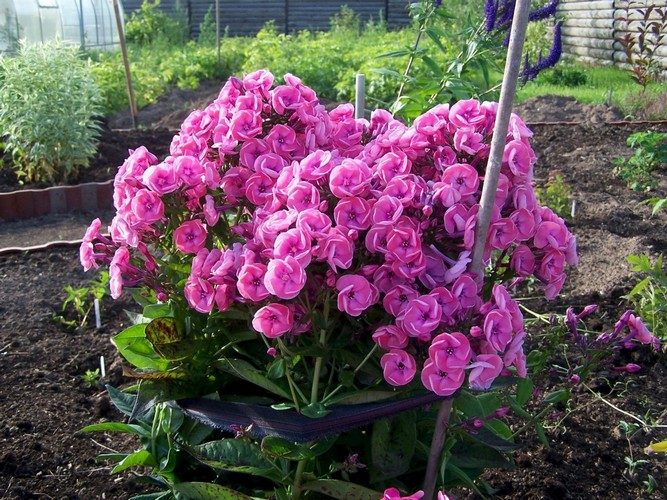

If the soil is clay, then coarse river sand, gravel, wood ash, peat, compost are added. In order to fertilize 1 square meter of soil, 7 kg of peat is required, about 300 grams of wood ash, about 5 kg of humus or compost. All components are thoroughly mixed, river sand or fine gravel, 30 grams of nitrophoska, 30 grams of potassium sulfate and the same amount of Agricola-7 are added to them.
Then the fertilized soil is dug up again. Phlox also like coniferous compost, although it is not available to everyone.
Description
It is a shrub about half a meter high with delicate flowers of white, blue, pink or blue. In the seventeenth century, the plant was brought to Europe from Virginia by botanical scientists. Thanks to John Tradescant and his son, John Tradescant Jr., the flower got its name.
The decorative appearance of the leaves and unusual inflorescences are very much appreciated by gardeners. Tradescantia is a perennial plant, the bush of which becomes more and more lush as it grows.
The plant can multiply using seeds. With this method, varietal qualities are not preserved, but it is possible to select seedlings that have new properties. Seed propagation is most often used by breeders.
Freshly harvested seeds germinate best. Sowing is done in spring or before winter, it is best to use wooden boxes for this purpose, which have drainage holes on the bottom. Light nutritious soil is poured into the container. The seeds are sown in rows, one to two centimeters apart. Leave 12-15 cm between the rows. Then sprinkle the seeds with soil mixture to a height of 1 cm. The boxes are placed in a greenhouse or greenhouse and covered with fallen leaves.
In early spring, when the snow melts, the shelter is removed. It is important not to allow the soil to dry out. In spring, Tradescantia is sown in the same way as other seedlings, from February to June, in the same way as when sowing in autumn.
Despite good care, seeds that were sown in spring germinate for a long time (more than 1 month) and give unsuccessful shoots. When one or two true leaves appear, the seedlings dive - when sowing before winter, immediately into the ground, when sowing in spring - into special containers. Seedlings are watered and fed every 7-10 days.
When sown before winter or early spring, some seedlings bloom in the second year. If sowing was late, flowering occurs in the second or third year.
Seedling is considered a good breeding method. Planted in the spring, before the onset of heat. In order for the plant to take well, it is recommended to pour humus with earth (50 x 50) into the prepared hole. A plant is placed in a hole and poured with warm water, covered with earth and lightly tamped.
The plant can be propagated by dividing the bush or using cuttings. The first option is more convenient. A favorable time for breeding is spring or autumn. Garden Tradescantia has a powerful root system, do not forget about this when digging in plants in order to remove it from the soil. Then a part is separated from the main bush and planted in the chosen place. Large bushes can be divided into several parts. It is advisable to transplant in the evening.
When propagating by cuttings, a stalk with leaves is cut off, placed in a container with water. After the appearance of roots 2 cm long, the plant is ready for planting. Trying not to damage the roots, the cutting is transplanted into a box or pot filled with ordinary soil.
The plant needs moderate watering. After the flower grows up, you can plant it in open ground.

